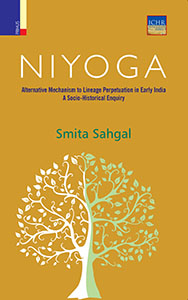
Niyoga: Alternative Mechanism to Lineage Perpetuation in Early India A Socio-Historical Enquiry
AUTHOR – Smita Sahgal
| HB ₹995 . $39.95 . ₤32.95 |
e-Book ₹895 . $35.95 . ₤29.95 |
|
INFORMATION
- AUTHOR : Smita Sahgal
- HB ISBN : 978-93-84082-85-7
- EBOOK ISBN : 978-93-84092-58-0
- HB Year : 2017, EBOOK Year: 2018
- Extent : 260 pp.
- Discount available on checkout
- Usually dispatched within 3 to 5 working days.
INFORMATION
- AUTHOR – Smita Sahgal
- ISBN – 978-93-84082-85-7
- Year – 2017
- Extent: 400 + 40 coloured illustrations
- 10% discount + free shipping
- Usually dispatched within 3 to 5 working days.
This book attempts to explore the institution of Niyoga in early India, examining its genesis and trajectory through the temporal and spatial canvas, for though the focus remains on the early period, the fluctuations are best studied over a larger span of time. The early texts refer to niyoga as apaddharma, a practice to be resorted to only in times of exigency. Niyoga allowed a married woman to cohabit with a designated male if her husband was infertile or had died without leaving an heir. Niyoga, therefore, emerged as an alternative to lineage perpetuation with due normative sanction. The institution had its beginnings in a pastoral set-up, but with changes in social formations, it also underwent many variations. As state societies gave way to regional polities, and as property issues became increasingly important, normative traditions evolved and mutated, and patriarchies changed their stance on the socio-sexual regulation of both men and women. With the passage of time, the institution of niyoga became marginalized within the legal framework, and yet, as this study shows, the practice continues to be espoused at local levels up to the modern era.
This book will be of lasting pertinence to scholars of History, Ancient History and gender Studies. It will also attract general readers who are interested in the subject. This also has the potential to invite the attention of the libraries of colleges and universities.
The Author
Smita Sahgal is Associate Professor of History at Lady Shri Ram College, University of Delhi. Her fields of specializations are History of Religion and Social History. She is the co-author of the very well-received book Teaching History and has published a number of articles in national and International journals. She is currently working on a project sponsored by Indian Council of Historical Research titled Masculinities in Early India; Exploring the Possibility of a Discourse.
This book attempts to explore the institution of Niyoga in early India, examining its genesis and trajectory through the temporal and spatial canvas, for though the focus remains on the early period, the fluctuations are best studied over a larger span of time. The early texts refer to niyoga as apaddharma, a practice to be resorted to only in times of exigency. Niyoga allowed a married woman to cohabit with a designated male if her husband was infertile or had died without leaving an heir. Niyoga, therefore, emerged as an alternative to lineage perpetuation with due normative sanction. The institution had its beginnings in a pastoral set-up, but with changes in social formations, it also underwent many variations. As state societies gave way to regional polities, and as property issues became increasingly important, normative traditions evolved and mutated, and patriarchies changed their stance on the socio-sexual regulation of both men and women. With the passage of time, the institution of niyoga became marginalized within the legal framework, and yet, as this study shows, the practice continues to be espoused at local levels up to the modern era.
This book will be of lasting pertinence to scholars of History, Ancient History and gender Studies. It will also attract general readers who are interested in the subject. This also has the potential to invite the attention of the libraries of colleges and universities.
The Author
Smita Sahgal is Associate Professor of History at Lady Shri Ram College, University of Delhi. Her fields of specializations are History of Religion and Social History. She is the co-author of the very well-received book Teaching History and has published a number of articles in national and International journals. She is currently working on a project sponsored by Indian Council of Historical Research titled Masculinities in Early India; Exploring the Possibility of a Discourse.
Table of Contents
Table of Contents
| Preface | ix-x |
| Acknowledgements | xi-xii |
| Foreword By Kumkum Roy | xiii-xiv |
| Introduction Niyoga: Alternative Mechanism Of Lineage Perpetuation In Early India (A Socio-Historical Enquiry) | xv-xiii |
| Defining Sexuality: Locating Its Logic In Early Indian Texts | 1-7 |
| Defining Niyoga And Ascertaining Its Genesis And Rationale | 8-20 |
| Advocacy Of The Practice Of Niyoga In Early Sanskrit And Non-Sanskrit Texts | 21-81 |
| Subtle Marginalization Of The Practice Of Niyoga | 82-99 |
| Niyoga On The Legal And Social Canvas Through Medieval India | 100-118 |
| Explaining The Marginalization And Continuity Of The Practice | 119-125 |
| Gendered Enquiry Into Niyoga | 126-175 |
| Levirate In Non-Indian Contexts | 176-190 |
| Representations Of Niyoga/Levirate In Modern And Contemporary Contexts In India | 191-207 |
| Appraising The Mutations In The Practice Of Niyoga Over Space, Time And Cultures | 208-222 |
| Conclusion | 223-226 |
| Bibliography | 227-233 |
| Index | 235-242 |




